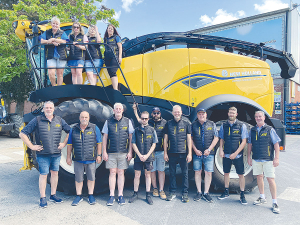NH tractor powered by methane goes on sale
First unveiled in 2023, New Holland has announced the addition of the T7.270 Methane Power CNG (Compressed Natural Gas) tractor to the recently expanded T7 Range.
 The group enjoyed factory tours and discussions with the technical, engineering and innovation teams.
The group enjoyed factory tours and discussions with the technical, engineering and innovation teams.
A group of eight Giltrap Agrizone customers travelled to Europe in July with managing director Andrew Giltrap, taking the opportunity to visit St Valentin, Austria, to see New Holland tractors being built.
The group then went onto Zedelgem in Belgium, to tour the New Holland manufacturing facility for the brand’s forage harvesters, combines and large square balers.
The group, all owners of New Holland FR Series forage harvesters, enjoyed factory tours, discussions with the technical, engineering and innovation teams, as well as technician training and insights highlighting the level of innovation and precision that goes into the development and manufacture of New Holland’s forage harvesters.
The visit was made possible by Giltrap Agrizone, with the support of New Holland. Andrew Giltrap said, “I haven’t taken customers to these factories before, but having sent staff there for training and having seen how the experience has increased their understanding and confidence, I could see the value in such a visit like this for our forage harvester customers. These foragers offer so much potential, so to be able to take customers there for training and to talk to the technicians, it’s definitely going to enable them to get the most out of their foragers and really fine-tune their performance.”
Customer John Clark said the trip had really opened his eyes to how much went into the manufacturing process and it had been valuable to see how the factory operated and meet the people behind the process.
“It was a really brilliant trip, and something I can now tick off my bucket list. The factory visits were a great experience and it was so interesting to see the manufacturing process from start to finish,” John said.
John and son Matthew operate John Clark Contracting at Otorohanga, south of Hamilton, where they have a fleet of tractors and balers, along with a NH forager used for grass and maize silage production, which they have had for eight years. A new FR780 is currently on its way to the southern hemisphere though, with their name on the side.
“It’s got all the NIR features on it, which played a big part in our decision to upgrade. The system offers a range of benefits for our business and will make what we are doing more efficient in terms of time and productivity,” John said.
New Holland NIR, referring to NutriSense, is a near-infrared (NIR) sensor technology, available on combines and forage harvesters, allowing real-time analysis of crop nutrients and moisture content during harvesting, providing valuable data for optimising yield and input management.
“NIR is a big step forward in the New Holland FR model, so the visit gave our customers who’ve purchased machines a better insight into the capability of the technology and just how much it can assist them in maximising their business operations and returns,” Andrew Giltrap said.
Federated Farmers says almost 2000 farmers have signed a petition launched this month to urge the Government to step in and provide certainty while the badly broken resource consent system is fixed.
Zespri’s counter-seasonal Zespri Global Supply (ZGS) programme is underway with approximately 33 million trays, or 118,800 tonnes, expected this year from orchards throughout France, Italy, Greece, Korea, and Japan.
Animal owners can help protect life-saving antibiotics from resistant bacteria by keeping their animals healthy, says the New Zealand Veterinary Association.
According to analysis by the Meat Industry Association (MIA), New Zealand red meat exports reached $827 million in October, a 27% increase on the same period last year.
The black and white coat of Holstein- Friesian cows is globally recognised as a symbol of dairy farming and a defining trait of domestic cattle. But until recently, scientists didn’t know which genes were responsible for the Holstein’s spots.
According to the New Zealand Dairy Statistics 2024/25 report, New Zealand dairy farmers are achieving more with fewer cows.